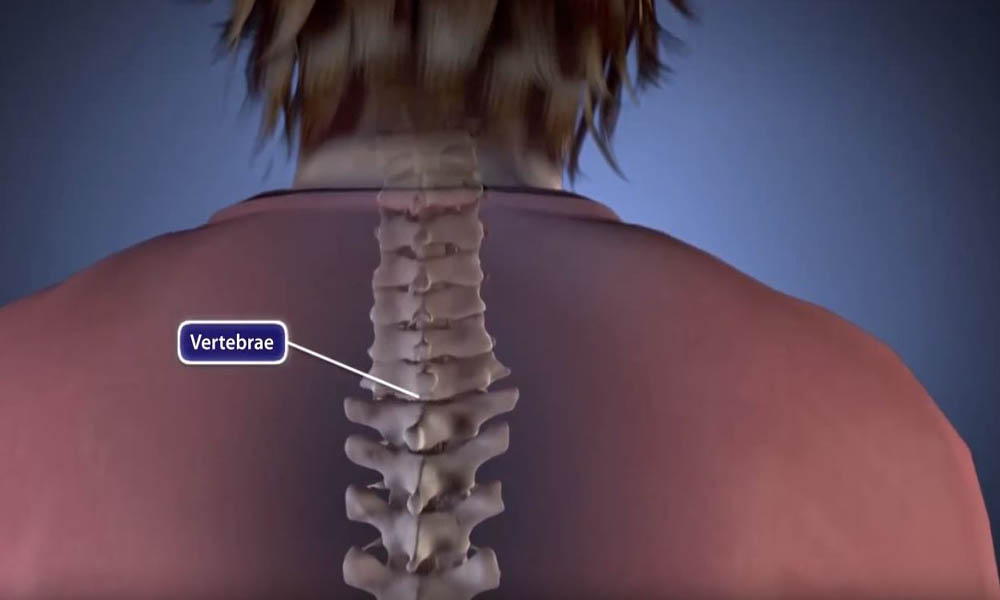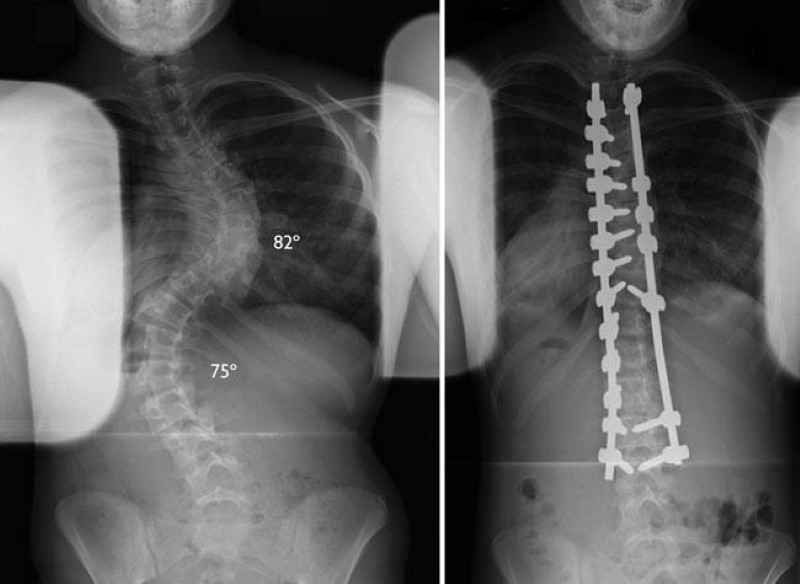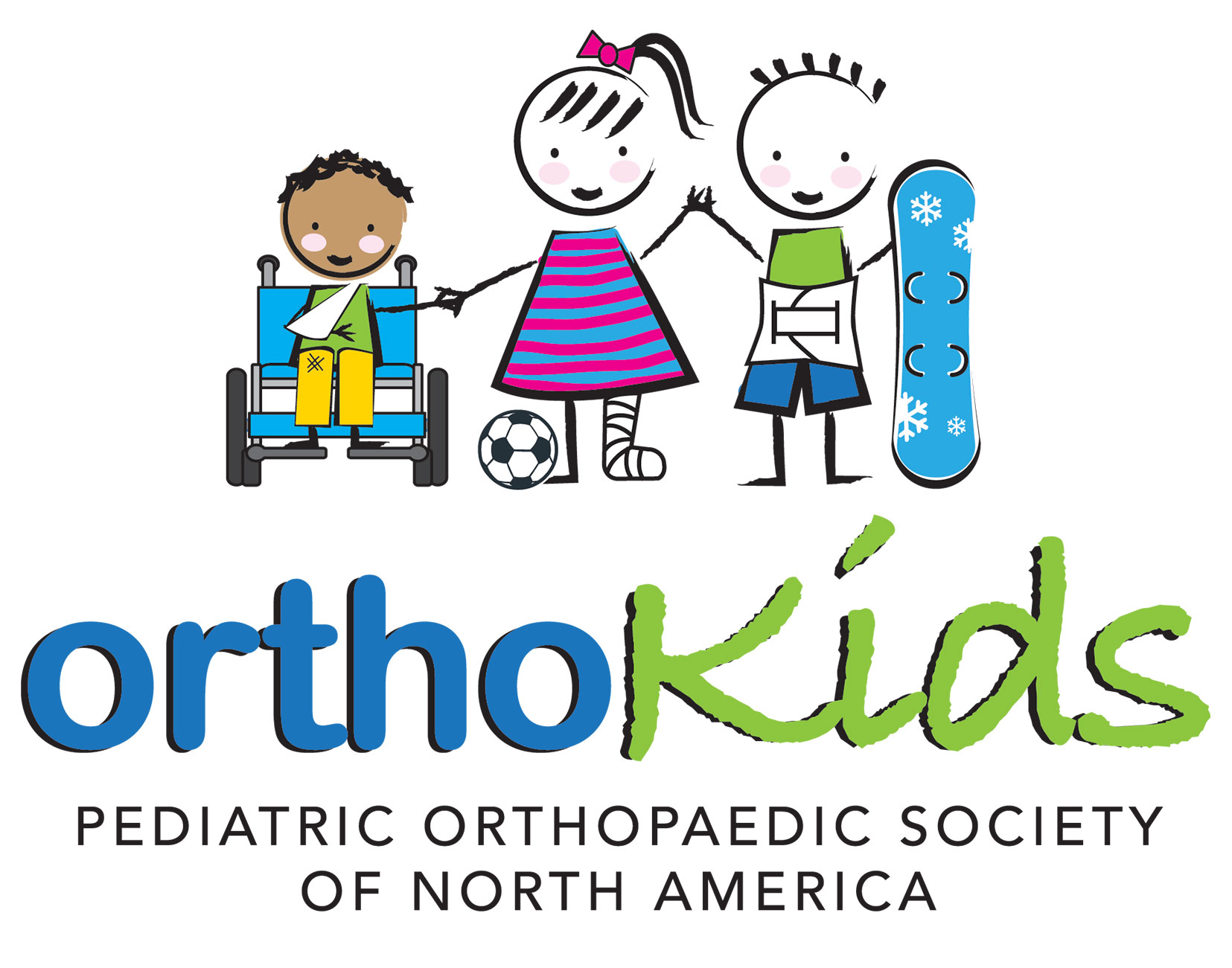Treatment
Surgical Treatment for Scoliosis
Most scoliosis surgeons agree that children who have very severe curves (45 to 50 degrees and higher) will need surgery to lessen the curve and prevent it from getting worse.
The most common surgery for scoliosis is a spinal fusion with metal rods and screws and a bone graft. The basic idea is to realign (straighten) and fuse (weld) together the curved vertebrae so that they heal into a single, solid bone.
Other "fusionless" surgery is also possible. In this surgery, screws are placed in the vertebrae and connected by cable. This surgery is called vertebral body tethering (VBT). Tension on the cable corrects the spine to a certain point, and continued growth after the surgery further straightens the spine. This procedure is designed for growing children and allows for motion in the part of the spine that was operated on.
With the tools and technology available today, scoliosis surgeons are able to improve curves significantly.
General Questions About Surgery for Scoliosis
Do I need surgery?
If your curve is greater than 45 to 50 degrees, it will very likely get worse, even after you are fully grown. This may increase the cosmetic deformity in your back, as well as affect your lung function. Surgery is recommended.
Curves between 40 and 50 degrees in a growing child fall into a grey area — several factors may influence whether surgery is recommended. These should be discussed with your surgeon.
How successful is surgery for scoliosis?
Spinal fusion is very successful in stopping the curve from growing. Today, doctors are also able to straighten the curve significantly, which improves the patient's appearance.
How straight will my spine be after surgery?
Because your spinal bones protect your spinal cord, your surgeon will straighten the bones only as far as is safe.
The degree of correction from surgery depends on how flexible your scoliosis is before your operation. In general, the more flexible your curve is, the better the correction from surgery. Your doctor can measure your flexibility before surgery with special X-rays called bending or traction films.
Most patients recover from surgery with curves that have been straightened to less than 25 degrees. In many cases, these small curves are hardly noticeable.
I have back pain associated with my scoliosis. Will the surgery relieve it?
Immediately after surgery, there will be more pain than before, but this usually goes away over a period of a few weeks to a few months. Most patients report that their back pain is better at 1 year after surgery than it was beforehand.
Everyone — whether there is scoliosis or not — has some back discomfort from time to time. Expecting to never have any future back pain is unrealistic.
Common Questions About Spinal Fusion for Scoliosis
What is involved with a spinal fusion surgery?
In a spinal fusion, the curved vertebrae are fused (welded) together so that they heal into a single, solid bone. This will stop growth completely in the abnormal segment of the spine and prevent the curve from getting worse.
All spinal fusions use some type of bone material, called a bone graft, to help the fusion happen. Generally, small pieces of bone are placed into the spaces on the vertebrae to be fused. The bone grows together — similar to when a broken bone heals.
Metal rods are typically used to hold the spine in place until fusion happens. The rods are attached to the spine by screws, hooks, and/or wires.
Exactly how much of the spine is fused depends on your curve(s).
What is a bone graft?
A bone graft is primarily used to stimulate bone healing. It increases bone production and helps the vertebrae heal together into a solid bone.
- Autograft. In the past, a bone graft harvested from the patient's hip was the only option for fusing the vertebrae. This type of graft is called an autograft. Harvesting a bone graft:
- May require an additional incision during the operation
- Increases the length of surgery
- Can cause increased pain after the operation because an additional region of the pelvis is included in the procedure
- Allograft. One alternative to harvesting a bone graft is using an allograft, which is cadaver bone. An allograft is typically acquired through a bone bank.
- Artificial bone grafts. Several artificial bone graft materials have also been developed. These artificial materials are often used along with an autograft or allograft.
How long does the surgery take?
Most fusions last 4 to 8 hours, depending on the size of the patient's curve and how much of the spine needs to be fused. Some of this time is spent:
- Preparing the patient for anesthesia
- Hooking the patient up to various monitors
- Positioning the patient to be as safe and comfortable as possible
How much pain will I be in after surgery?
The amount of pain people report after surgery varies a great deal from patient to patient. The surgery is a major procedure that involves moving muscles and realigning the skeleton.
The first few days are usually quite uncomfortable, but most people improve rapidly by the third or fourth day, and they can walk around, and get in and out of bed well enough to go home by then. The pain continues to improve gradually, and most teenagers can return to school by 4 to 6 weeks after surgery.
Mild pain may persist (continue), but by 3 to 6 weeks after surgery, pain medication should no longer be necessary.
What type of pain control will there be after the operation?
Pain control varies between different doctors and hospitals.
- In many cases, a PCA (patient-controlled anesthesia machine) is used. The machine injects a small dose of pain medicine intravenously (through an IV tube) when the patient pushes a button.
- Some surgeons use an intravenous catheter (a small plastic tube placed in a vein) to provide the medication in larger but less frequent doses.
The pain relief system that your doctor uses is probably the safest and most reliable for you after surgery in that particular institution.
On the second or third day after surgery, your doctor will most likely change your medication to pills or liquid pain relievers taken by mouth. These medications are opioids (morphine-like medicine), which are narcotics. Because opioids are known to be addictive if taken for a long time, you may be encouraged to switch to a non-opioid pain medication as soon as possible after you go home.
Do the rods and other implants stay in my spine even after it has fused?
If rods are used in a fusion, they usually are not removed. Very few people require rod removal. When it is required, this may be for a variety of reasons, such as an infection or broken rod.
Will fusion make my back stiff and unable to move?
The fused portion of your back will be permanently stiff.
- Most people have enough motion in the unfused portion of their lower backs to perform all activities of daily living and most sports.
- If you participate in activities that require a tremendous amount of flexibility, it may take awhile to adapt. Most people find that, within 1 year or so, their backs begin to feel "normal" when participating in those activities.
Can I have my scoliosis corrected without a fusion?
Several institutions are investigating fusion-less spine surgery (vertebral body tethering, or VBT, described in the introduction) in younger patients with moderate curves (45 to 50 degrees) who are still growing.
However, more patient follow-up is needed to determine the usefulness of tethering growth modulation surgery and its lasting effect. Currently the risk of the tether breaking is significant, and if the tether breaks, it may require another operation. At this time, the gold standard for surgical treatment of scoliosis is still fusion surgery.
Common Questions About Surgical Recovery
Most patients are:
- In the hospital for 3 to 4 days
- Out of school for 4 to 6 weeks
- Back into activities in 2 to 6 months
How long do patients need pain medication after being discharged home?
Most surgeons prescribe strong pain medications to patients after scoliosis surgery. Patients who have not used opioid pain medications before usually stop needing them within 2 weeks after surgery. If the patient has used these medicines frequently before surgery, it may take longer to stop needing them.
It is best to stop taking these strong medications as soon as possible because they can be addictive if taken for long periods of time.
What limitations will I have right after surgery?
Your surgeon will detail any limitations you have after surgery. Most patients will be asked to avoid heavy lifting and to minimize the amount of bending forward for the first 6 weeks.
Does surgery lead to permanent restrictions on activities?
No. Most patients are able to return to all of their favorite activities and sports. Most patients return to non-contact sporting activities (running, weightlifting, etc.) within 4 to 6 months after surgery.
Before returning to all activities, including contact sports, the spine must be fully healed. It typically takes 6 to 12 months after surgery to obtain a solid fusion of the spine and allow a return to unrestricted activities.
Will I be able to walk after surgery?
Yes. Some patients may need physical therapy after surgery, but they are able to walk when they are discharged from the hospital.
When can I go back to school after the operation?
Most children miss 4 to 6 weeks of school after surgery. It typically takes about 4 weeks before the spine is healed enough to carry a backpack.
When will I be allowed to drive a car?
You will not be able to drive a car until you have healed well enough from surgery. In addition to being off of your narcotic pain medicines, you need to be moving around well enough to be safe. This typically takes 6 or more weeks.
When can I start hanging out with my friends again?
Your friends can visit you after surgery in the hospital and at home. Going out with your friends — like to school functions or the movies — can occur after you are off all pain medications and are feeling back to normal (this usually happens about 4 to 6 weeks after surgery).
Contributed and/or Updated by
Peer-Reviewed by
AAOS does not endorse any treatments, procedures, products, or physicians referenced herein. This information is provided as an educational service and is not intended to serve as medical advice. Anyone seeking specific orthopaedic advice or assistance should consult his or her orthopaedic surgeon, or locate one in your area through the AAOS Find an Orthopaedist program on this website.









